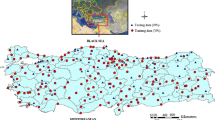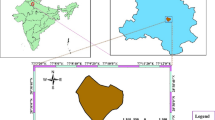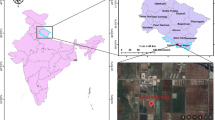Abstract
Changes in potential evapotranspiration will affect the surface ecology and environment of the land. Accurate and quick estimation of potential evapotranspiration will help to analyze environmental change. In this study, in combination with the canonical correlation analysis (CCA) and k-nearest neighbor algorithm (k-NN), a new method for calculating potential evapotranspiration (CCA-k-NN) based on self-optimizing nearest neighbor algorithm was proposed, in which less meteorological data were used for estimation. By analyzing the basic principles of CCA and k-NN and according to the requirement of estimating ET0, the CCA-k-NN method was constructed, and its basic principles and key steps were described. In this method, CCA algorithm was used to find the most relevant meteorological data for potential evapotranspiration, and the dimensionality of meteorological data for subsequent estimation of ET0 was reduced. Then, k-NN algorithm was used to estimate ET0. The Northwest of China was chosen as the research area to evaluate the applicability of this method. The 148 data stations in the region were divided into training datasets, testing datasets, and validation datasets. ET0 was estimated on three datasets using the proposed method, and the estimation accuracy of the CCA-k-NN method was evaluated with FAO-56 Penman-Monteith as a reference. The results show that the CCA-k-NN method maintains a high correlation with FAO-56 Penman-Monteith (correlation coefficient is greater than 0.9) and has a good estimation accuracy. RMSE and MAE are both less than 1 mm day−1, and the overall performance of NSCE is greater than 0.5, all of which reach the level of “applicable” and above. At the same time, the CCA-k-NN method has low time complexity O(n). Comparison of the results of the CCA-k-NN method with those of other empirical models showed that the CCA-k-NN method is more accurate and can be employed successfully in estimating ET0.











Similar content being viewed by others
References
Adnan M, Latif MA, Nazir M (2017) Estimating evapotranspiration using machine learning techniques. Int J Adv Comput Sci Appl 8(9):108–113. https://doi.org/10.14569/ijacsa.2017.080915
Allen RG, Pereira LS, Raes D, Smith M (1998) Crop evapotranspiration-guidelines for computing crop water requirements-FAO irrigation and drainage paper 56. Fao, Rome, 300(9), D05109. http://www.fao.org/3/X0490E/x0490e00.htm
Awada A, Wegmann B, Viering I, et al. (2011) Self-optimization algorithm for inter-RAT configuration parameters.2011 8th International Symposium on Wireless Communication Systems. IEEE: 311-316. https://doi.org/10.1109/iswcs.2011.6125374
Birhanu D, Kim H, Jang C, Park S (2018) Does the complexity of evapotranspiration and hydrological models enhance robustness? Sustainability 10(8). https://doi.org/10.3390/su10082837
Yu F, Ningbo C, Daozhi G, Xinping W, Wang J (2015) Prediction model of reference crop evapotranspiration based on extreme learning machine. Transactions of the CSAE 31(S1):153–160 http://dx.chinadoi.cn/10.3969/j.issn.1002-6819.2015.z1.018
Yu F, Ningbo C, Daozhi G, Xiaotao H, Kuandi Z (2016) Modeling reference evapotranspiration by generalized regression neural network combined with temperature data. Transactions of the CSAE 32(10):81–89 + 315. http://dx.chinadoi.cn/10.11975/j.issn.1002-6819.2016.10.012
Goyal MK, Bharti B, Quilty J, Adamowski J, Pandey A (2014) Modeling of daily pan evaporation in sub tropical climates using ANN, LS-SVR, Fuzzy Logic, and ANFIS. Expert Syst Appl 41(11):5267–5276. https://doi.org/10.1016/j.eswa.2014.02.047
Hargreaves GH, Samani ZA (1985) Reference crop evapotranspiration from temperature. Appl Eng Agric 1(2):96–99. https://doi.org/10.13031/2013.26773
Hernández S, Morales L, Sallis P (2011) Estimation of reference evapotranspiration using limited climatic data and bayesian model averaging. https://doi.org/10.1109/ems.2011.81
Zhiqiang HOU, Peiling YANG, Yanping SU, Shu-mei R (2011) Simulation of ET0 based on LS-SVM method. J Hydraul Eng 42(06):743–749 http://dx.chinadoi.cn/10.13243/j.cnki.slxb.2011.06.011
Huo Z, Feng S, Kang S, Dai X (2012) Artificial neural network models for reference evapotranspiration in an arid area of Northwest China. J Arid Environ 82:81–90. https://doi.org/10.1016/j.jaridenv.2012.01.016
Hardoon DR, Szedmak S, Shawe-Taylor J (2004) Canonical correlation analysis: an overview with application to learning methods. Neural Comput 16(12):2639–2664. https://doi.org/10.1162/0899766042321814
Kisi O (2015) Pan evaporation modeling using least square support vector machine, multivariate adaptive regression splines and M5 model tree. J Hydrol 528:312–320. https://doi.org/10.1016/j.jhydrol.2015.06.052
Kumar M, Bandyopadhyay A, Raghuwanshi NS, Singh R (2008) Comparative study of conventional and artificial neural network-based ETo estimation models. Irrig Sci 26(6):531–545. https://doi.org/10.1007/s00271-008-0114-3
Landeras G, Ortiz-Barredo A, López JJ (2008) Comparison of artificial neural network models and empirical and semi-empirical equations for daily reference evapotranspiration estimation in the Basque Country (Northern Spain). Agric Water Manag 95(5):553–565. https://doi.org/10.1016/j.agwat.2007.12.011
Xiaoyu LI (2018) Optimal neighbor parameter of k-nearest neighbor algorithm for collaborative filtering recommendation. Compu and Digi Engi 46(08):1525–1528 + 1619. http://dx.chinadoi.cn/10.3969/j.issn.1672-9722.2018.08.009
Manikumari N, Murugappan A, Vinodhini G (2017) Time series forecasting of daily reference evapotranspiration by neural network ensemble learning for irrigation system. IOP Conference Series: Earth and Environmental Science 80. https://doi.org/10.1088/1755-1315/80/1/012069
Mattar MA (2018) Using gene expression programming in monthly reference evapotranspiration modeling: a case study in Egypt. Agric Water Manag 198:28–38. https://doi.org/10.1016/j.agwat.2017.12.017
Moriasi DN, Arnold JG, Van Liew MW, Bingner RL, Harmel RD, Veith TL (2007) Model evaluation guidelines for systematic quantification of accuracy in watershed simulations. Trans ASABE 50(3):885–900. https://doi.org/10.13031/2013.23153
Nema MK, Khare D, Chandniha SK (2017) Application of artificial intelligence to estimate the reference evapotranspiration in sub-humid Doon valley. Appl Water Sci 7(7):3903–3910. https://doi.org/10.1007/s13201-017-0543-3
Scheit O (2014) Self-Healing in Self-Organizing Networks. In Seminar Innovative Internettechnologien und Mobilkommunikation SS2014. https://doi.org/10.2313/NET-2014-08-1_22
Tahir SA (1998) Estimating potential evaporation using artificialneural network. In Water and land resources development and management for sustainable use. Vol. II–A, 10th ICID Afro–Asian Regional Conference on Irrigation and Drainage.New Delhi, India: ICID Publications
Tezel G, Buyukyildiz M (2016) Monthly evaporation forecasting using artificial neural networks and support vector machines. Theor Appl Climatol 124(1-2):69–80. https://doi.org/10.1007/s00704-015-1392-3
Torres AF, Walker WR, McKee M (2011) Forecasting daily potential evapotranspiration using machine learning and limited climatic data. Agric Water Manag 98(4):553–562. https://doi.org/10.1016/j.agwat.2010.10.012
Sheng W, Hongsong C, Yunpeng N, Zhiyong F, Wang K, Yali D (2015) Simulation of reference evapotranspiration based on gene-expression programming method. Transactions of the CSAM 46(04):106–112 http://dx.chinadoi.cn/10.6041/j.issn.1000-1298.2015.04.016
Xueyan WU, Shuihua WANG, Yudong Z (2017) Survey on theory and application of k-nearest-neighbors algorithm. Compu Engin and Appl 53(21):1–7 http://dx.chinadoi.cn/10.3778/j.issn.1002-8331.1707-0202
Yassin MA, Alazba AA, Mattar MA (2016) Modelling daily evapotranspiration using artificial neural networks under hyper arid conditions. Pak J Agric Sci 53(09):695–712. https://doi.org/10.21162/pakjas/16.3179
Acknowledgments
This study was supported by the university first-class discipline construction project of Ningxia, China (Grant No.NXYLXK2017A03); the Natural Science Foundation of Ningxia, China (Grant No. 2019AAC03049); the scientific research project of Ningxia Colleges and universities, China (Grant No. NGY2017026), and the China Scholarship Council (Grant No.201708645016).
Author information
Authors and Affiliations
Corresponding author
Additional information
Responsible editor: Marcus Schulz
Publisher’s note
Springer Nature remains neutral with regard to jurisdictional claims in published maps and institutional affiliations.
Electronic supplementary material
ESM 1
(DOCX 15 kb)
Rights and permissions
About this article
Cite this article
Feng, K., Tian, J. Estimating potential evapotranspiration based on self-optimizing nearest neighbor algorithms: a case study in arid–semiarid environments, Northwest of China. Environ Sci Pollut Res 27, 37176–37187 (2020). https://doi.org/10.1007/s11356-019-06597-7
Received:
Accepted:
Published:
Issue Date:
DOI: https://doi.org/10.1007/s11356-019-06597-7




